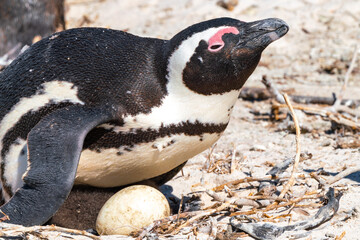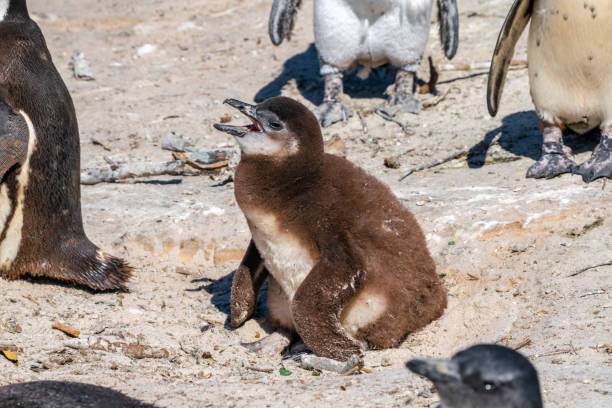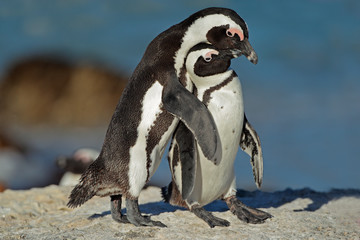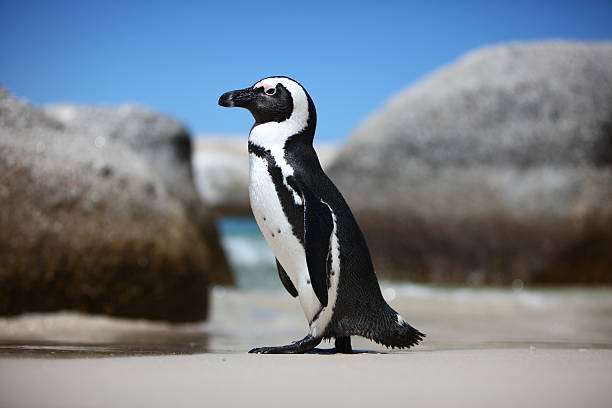Table of Contents
Scientific Classification
| Kingdom | Animalia |
| Phylum | Chordata |
| Class | Aves |
| Order | Sphenisciformes |
| Family | Spheniscidae |
| Genus | Spheniscus |
| Species | Spheniscus demersus |
| Scientific Name | Spheniscus demersus |
Description
The African Penguin (Spheniscus demersus) is a small, flightless seabird often referred to as the jackass penguin due to its distinctive braying call. These penguins inhabit the coastlines of Southern Africa and are easily recognizable by their striking black-and-white plumage. They feature a black band across their chest and a unique arrangement of black spots, similar to a human fingerprint. Their streamlined bodies are designed for swift swimming, and their sharp beaks are well-suited for catching slippery prey.

Distribution
African Penguins are found along the coasts of South Africa and Namibia. They utilize approximately 28 breeding sites, which consist of islands and colonies on the mainland. The largest populations can be seen at:
Boulders Beach (South Africa)
St. Croix Island (South Africa)
Dassen Island (South Africa)
Mercury Island (Namibia)
Their range was once much broader, but habitat loss and other factors have significantly reduced their distribution.
Habitat
Unlike their Antarctic relatives, African Penguins thrive in temperate coastal environments. Their preferred habitats include:
- Rocky shores – Providing shelter and nesting spaces.
- Sandy beaches – Where they dig burrows to escape extreme heat.
- Offshore islands – Offering safety from terrestrial predators.
- Shallow coastal waters – Rich in fish, their primary food source.
These birds rely on stable marine ecosystems. So, they are quite vulnerable to changes in the environment.

Diet
African Penguins are carnivorous and mainly eat marine life, which includes:
Small fish – Primarily sardines and anchovies, making up the majority of their diet.
Squid and crustaceans – These help to meet their nutritional requirements.
Krill – Sometimes eaten, but not a major part of their diet.
They are excellent hunters, capable of diving to depths of 30 to 60 meters (100 to 200 feet). Their powerful flippers enable them to swim swiftly, reaching speeds of up to 20 km/h (12 mph).
Behavior
African Penguins are very social birds. You often find them in colonies. They work together in ways like:
- Vocal Communication – They use distinct brays, honks, and chirps to communicate.
- Grooming and Preening – Strengthening social bonds and keeping feathers waterproof.
- Thermoregulation – Spreading their wings or seeking shade to manage body temperature.
- Cooperative Foraging – Often hunting in groups to increase efficiency.
These behaviors make them fascinating to observe, especially in their natural habitats.
Lifespan
In the wild, African Penguins typically have a lifespan of 10 to 15 years, although some individuals can reach up to 20 years. In captivity, they are protected from predators and receive veterinary care, which allows them to live even longer.

Reproduction and Lifecycle
African Penguins are known for their monogamous nature, often forming lifelong partnerships with their mates. Their reproductive cycle consists of several key stages:
Nesting Season – They breed throughout the year, but the peak breeding times occur from March to May in South Africa and from November to December in Namibia.
Egg-Laying – The female typically lays two eggs per clutch, which both parents incubate for a period of 38 to 42 days.
Chick Rearing – Once the chicks hatch, they remain in the nest with their parents for about two to three months.
Fledging – The young penguins develop their feathers and eventually leave the nest to venture into the ocean.
Maturity – They usually reach sexual maturity at around three to four years of age.
Parental investment plays a crucial role, as both parents are involved in feeding and protecting their chicks.

Predators
African Penguins face predation from both natural and human-induced threats.
Natural Predators:
- Cape Fur Seals – Preying on both adult penguins and juveniles at sea.
- Sharks – Occasionally hunting penguins in deeper waters.
- Kelp Gulls – Targeting eggs and young chicks.
- Mongooses and Snakes – Threatening eggs in mainland colonies.
Human Threats:
- Overfishing – Depleting the penguins’ primary food sources.
- Oil Spills – Coating feathers and reducing their insulation and buoyancy.
- Habitat Destruction – Resulting from coastal development and tourism.
Adaptations
African Penguins have evolved various adaptations to survive in their coastal habitats:
- Waterproof Feathers – Dense and overlapping feathers provide insulation and buoyancy.
- Counter-Shading – Their black-and-white coloring offers camouflage from predators.
- Salt Glands – These glands are near their eyes and help remove extra salt from seawater.
- Streamlined Bodies – Enabling swift movement through the water.
- Sharp Beaks – Ideal for grasping slippery fish.
These adaptations ensure their survival in the wild, even under challenging conditions.
Conservation Status
African Penguins are currently listed as Endangered on the IUCN Red List, with their population having declined by over 60% in the past century.
Threats:
Commercial Overfishing – This reduces the availability of essential food sources like sardines and anchovies.
Climate Change – Changes in sea temperatures and food distribution are impacting their survival.
Oil Pollution – Significant oil spills have caused severe damage to penguin colonies in the past.
Human Disturbance – Activities related to tourism and industry disrupt their nesting habitats.
Conservation Efforts:
Marine Protected Areas (MPAs) – These areas limit fishing to help preserve food sources for the penguins.
Artificial Nesting Sites – Creating safe breeding grounds for the penguins.
Rescue and Rehabilitation – Organizations such as SANCCOB work to rehabilitate oiled and injured penguins.
Public Awareness Campaigns – Initiatives aimed at educating local communities about conservation efforts.
Ongoing conservation efforts are crucial to ensure the survival of this remarkable species.
Conclusion
The African Penguin is a resilient and captivating bird that plays a vital role in marine ecosystems. Unfortunately, its survival is jeopardized by human activities and environmental changes. To protect these seabirds, we need global awareness, conservation initiatives, and sustainable fishing practices. Efforts in conservation and responsible ecotourism are essential for ensuring that future generations can appreciate African Penguins along the Southern African coast.



